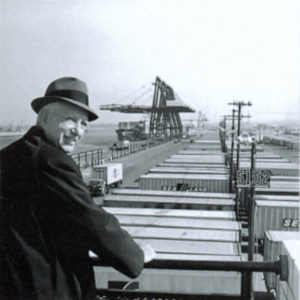
Dzieci Theatre’s Makbet
Our world floats inside containers.
The familiar steel boxes, with their 8 x 8.5-foot openings that lengthen into 20 or 40-foot segments, are just right for stacking on cargo ships or hauling down the highway on trains or trucks. Containers have transformed global commerce since the American businessman Malcolm McLean patented the design in 1956. It’s not an exaggeration, as Craig Martin says in his excellent Object Lessons book Shipping Container, that “our everyday lives are utterly determined by these metal boxes” (8). Almost everything I can see in my house right now — wood, drywall, metal and other building materials, furniture, the clothes I’m wearing, the MacBook I’m typing on, the dog toys on the floor, the leash still attached to the sleeping puppy’s collar — everything except the puppy himself, really — traveled here in a container, over waves, rails, or highways. #worldinabox
I’m been obsessed with shipping containers for years. So when my friend Liza Blake social media’d the news that the Dzieci Theatre Company was producing a slimmed-down version of Macbeth inside a shipping container, I got there two nights later. Such a glorious, intense, musical, & powerful performance! Now I want to put all my favorite plays inside boxes.

Malcolm McLean at Port Newark
When I showed up at the Sure We Can recycling center in Bushwick about 20 min before the 7 pm showtime, I wasn’t sure I was in the right place. The mostly-open lot is a maze of stacked pallets and piles of aluminum cans packed up in clear plastic bags. I didn’t see anyone who looked theatre-bound, but it was an intriguing space with colorful graffiti art, so I wandered around in the lingering twilight. Someone found me and asked “Are you here for Makbet?” He threaded me through the maze to an open fire in a half-sized oil drum, around which the members of the company were gathering on what was the first chilly evening of October. One member of the group, after checking her phone, addressed me by name. I plead vegetarianism when they offered kielbasa wrapped in newspaper, but I accepted a small glass of vodka. Mostly the people there were members of the company; clearly the container would not be full on a Friday night. They remembered Liza and her mom from last week. It was odd but good to share a drink before we all went inside.

Sure We Can Recycling Center
The rules of the game for Makbet-in-a-box stated that the main roles would announce themselves through a series of costume props: a black hat for Makbet, red shawl for his Lady, berets for Banquo and Fleance, spectacles for Prince Malcolm, a bandanna for MacDuff. A trenchcoat would be worn in succession by three kings of Scotland: Duncan, Makbet, and finally Malcolm. Three members of the company alternated these props as they exchanged the principal roles. I’m pretty sure the three members who took the main parts shift from night to night; the trio I saw included Matt Mitler, the founder of the company; Megan Bones; and Ryan Castalia. After the three chanted the Weird Sisters’ opening, Mitler wore the Makbet hat for the warrior’s meeting with the Sisters in the wood — but as the play proceeded all three actors played all the parts. We were treated to three different Makbets inside the narrow metal box — Mitler played him as speculative and deeply focused on the air-drawn dagger; Bones was manic and expressive; Castalia intense and withdrawn, especially when he was wearing the monarchal coat in the second half of the play. Watching the actors pass the roles among themselves highlighted the play’s recursive focus on ambition, violence, loss, and the lure of visionary knowledge. I’ve seen a lot of good productions of this play, but none quite like this one.

An out of focus pre-show fire
Working with a compressed script and taking advantage of the narrow steel walls for sound effects and a claustrophobic mood, the company generated a powerfully ritualized version of Shakespeare’s dark tragedy. Being inside the container focused and compressed the play, as Mitler recognized. I missed a few cut lines — the “two spent swimmers, that do cling together / And choke their art” (1.2) are particular favorites — but I loved the abrupt turns of the role-switching. And I loved that it all fit inside the box.
Before the showed started but after we were seated on milk crates inside, Mitler offered to provide readings from the spirit world for members of the audience. Mine was a vision of bowling pins, just one of which I managed to strike with a rolling ball in the vision. That one pin fell onto its neighbor, and that one onto the next and the next. Not all the pins fell down, but the ones that fell opened up a line, or opening, through which it might be possible to advance.
I’m still thinking about this vision: a path, but inside the container?
After the final battle and the tyrant’s death, wonderfully staged and punctuated by the rattle of human bodies crashing into steel walls, the trio ritually re-packed the costume props inside a large pot. I had a long drive home to CT, so I could not linger, but I stayed for a minute around the fire to break bread, and to talk about maybe bringing the company out to St. John’s sometime. I wonder if they travel with a container? 
You’ve still got a few days to see this one! Closes 10/21. Get down to the recycling center and get inside the box!